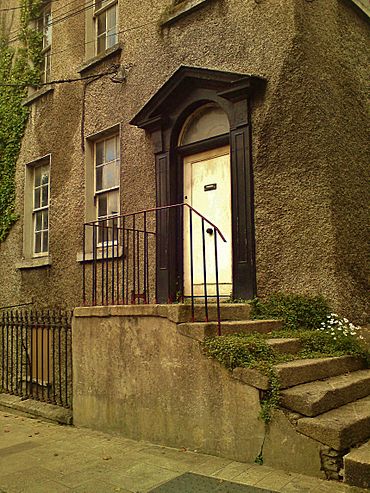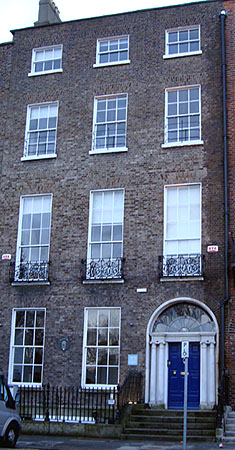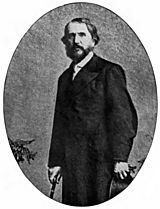Sheridan Le Fanu facts for kids
Quick facts for kids
Sheridan Le Fanu
|
|
|---|---|
 |
|
| Born | Joseph Thomas Sheridan Le Fanu 28 August 1814 Dublin, Ireland |
| Died | 7 February 1873 (aged 58) Dublin, Ireland |
| Occupation | Novelist |
| Language | English |
| Genre | Gothic horror, mystery |
| Literary movement | Dark romanticism |
| Spouse | Susanna Bennett |
| Children | Eleanor, Emma, Thomas, George |
Joseph Thomas Sheridan Le Fanu (born August 28, 1814 – died February 7, 1873) was an Irish writer. He was famous for his spooky "Gothic" stories, mystery novels, and horror tales. He was one of the best ghost story writers of his time, especially during the Victorian era (when Queen Victoria ruled Britain).
A famous writer named M. R. James said Le Fanu was "absolutely in the first rank as a writer of ghost stories." Some of his most well-known books include the mystery Uncle Silas, the vampire story Carmilla, and the historical novel The House by the Churchyard.
Contents
Early Life and Family
Sheridan Le Fanu was born in Dublin, Ireland. His family had roots in France (they were Huguenots, a group of French Protestants), Ireland, and England. He had an older sister, Catherine, and a younger brother, William. His parents were Thomas Philip Le Fanu and Emma Lucretia Dobbin.
His family was very creative! His grandmother, Alicia Sheridan Le Fanu, and his great-uncle, Richard Brinsley Sheridan, were both playwrights (people who write plays). His mother was also a writer.
When he was very young, his family moved to the Royal Hibernian Military School in Phoenix Park, Dublin. His father, who was a clergyman (a religious leader) in the Church of Ireland, became the chaplain there. Phoenix Park and the nearby village of Chapelizod later appeared in Le Fanu's stories.

In 1826, his family moved to Abington, in County Limerick, where his father took another church job. Even though he had a tutor, Le Fanu mostly taught himself by reading books in his father's large library. By age fifteen, he was already writing poetry. His father was a very strict religious man.
Around 1832, there were some troubles in the area called the Tithe War. This was a time when farmers, including many Catholics, were forced to pay money (called tithes) to support the Protestant church. This caused a lot of unrest. The next year, his family moved back to Dublin for a while.
Later Life and Writing Career
Le Fanu's family often struggled with money. His father's income from the church jobs decreased a lot during the Tithe War. When his father passed away, he had very little money to leave to his sons.
Sheridan Le Fanu studied law at Trinity College Dublin. He was called to be a lawyer in 1839, but he never actually worked as one. Instead, he chose to become a journalist. In 1838, he started writing stories for the Dublin University Magazine. His very first ghost story, "The Ghost and the Bone-Setter," was published then. He later owned several newspapers, like the Dublin Evening Mail.
In 1844, Le Fanu married Susanna Bennett. Her father was a well-known lawyer in Dublin. They had four children: Eleanor, Emma, Thomas, and George.
In 1847, Le Fanu spoke out about the terrible Irish Famine. He was concerned that the government wasn't doing enough to help.
In 1856, the family moved into Susanna's parents' house at 18 Merrion Square in Dublin. Le Fanu rented the house from his brother-in-law.
Sadly, Le Fanu's wife, Susanna, became very unwell and passed away in 1858. This was a very difficult time for him, and he felt a lot of sadness. He didn't write any fiction for a few years after her death.
In 1861, he became the editor and owner of the Dublin University Magazine. He started publishing his novels in parts (like a TV series) in the magazine first, and then he would change them a bit for English readers. He published The House by the Churchyard and Wylder's Hand this way.
His book Uncle Silas (1864) became very popular. It was set in England, which his publisher thought would appeal more to English readers. Later in his life, Le Fanu also found inspiration in Irish folklore for his short stories.
Sheridan Le Fanu passed away from a heart attack in Dublin on February 7, 1873, when he was 58 years old. Today, there's a road and a park in Dublin named after him.
His Works and Style
Le Fanu wrote in many different styles, but he is most famous for his horror stories. He was very careful with his writing and often reused ideas from his older stories in new ways. Many of his novels, for example, were longer versions of earlier short stories.
He was good at creating a spooky mood and atmosphere, rather than just using "jump scares." He often left important details unclear and mysterious. He also liked to hint at supernatural events without fully explaining them. For example, a demonic monkey in his story "Green Tea" might just be something the main character imagines. This way of writing influenced many horror writers and filmmakers later on.
His best stories, like the vampire tale Carmilla and "Schalken the Painter," are still considered very powerful. He had a huge impact on M. R. James, another famous ghost story writer. Even though his work wasn't as popular for a while, interest in his stories has grown a lot since the late 1900s.
Early Stories: The Purcell Papers
His first twelve short stories, written between 1838 and 1840, were supposedly found writings of an 18th-century priest named Father Purcell. They were published in the Dublin University Magazine and later collected in a book called The Purcell Papers (1880).
These stories are mostly set in Ireland and include classic Gothic horror elements, like dark castles and visits from ghosts. They also show a sadness for the old Catholic noble families of Ireland, whose ruined castles stood as reminders of their past. Some of these stories are still found in collections today:
- "The Ghost and the Bonesetter" (1838): His first published story, which is a bit funny.
- "The Fortunes of Sir Robert Ardagh" (1838): A mysterious story about a deal with a dark force, set in a spooky Irish castle.
- "Strange Event in the Life of Schalken the Painter" (1839): A creepy story inspired by the paintings of a 17th-century Dutch artist named Godfried Schalcken. M. R. James thought this was one of Le Fanu's best stories. It was even made into a TV show by the BBC in 1979.
- "A Chapter in the History of a Tyrone Family" (1839): This story might have influenced Charlotte Brontë's famous novel Jane Eyre.
Historical Novels
Le Fanu's first novels were historical stories, similar to those by Sir Walter Scott, but set in Ireland. They often looked back at the past with sympathy for old causes.
- The Cock and Anchor (1845): A story about old Dublin.
- The House by the Churchyard (1863): This was his last novel set in the past and in Ireland. It mixes his historical style with his spooky Gothic style. This novel is set in Chapelizod, where Le Fanu lived as a child.
Sensation Novels
Le Fanu also wrote many novels in the "sensation fiction" style, which was popular at the time. These were exciting stories with lots of twists and turns, like those by Wilkie Collins.
- Wylder's Hand (1864)
- All in the Dark (1866): This story makes fun of spiritualism, which was a popular belief in talking to spirits.
- The Rose and the Key (1871): This book describes the scary side of private mental hospitals, which was a common theme in Gothic stories.
Major Works
His most famous works, which people still enjoy reading today, include:
- Uncle Silas (1864): A dark mystery novel and a classic Gothic horror story. It was made into a film in 1947 and again in 1987.
- In a Glass Darkly (1872): This is a collection of five short horror and mystery stories. They are presented as if they were found papers of a special detective named Dr. Hesselius.
- "Green Tea": A haunting story about a man bothered by a demonic monkey.
- "The Familiar": A slightly changed version of his 1847 story "The Watcher." M. R. James believed this was the best ghost story ever written.
- "Mr Justice Harbottle": Another spooky story about a journey to a dark place.
- "The Room in the Dragon Volant": A mystery story, not a ghost story, that includes the scary idea of being buried alive by mistake.
- "Carmilla": A captivating story about a female vampire, set in central Europe. This story has inspired many films, including The Vampire Lovers (1970) and Vampyr (1932). It also played an important role in how vampires are shown in modern books and movies.
Legacy and Influence
Many writers have admired Le Fanu's stories. E. F. Benson, another ghost story writer, said that Le Fanu's stories like "Green Tea" and "The Familiar" are incredibly scary and never get old. He added that Le Fanu was "unrivalled" at creating a mysterious atmosphere where horror can grow.
Jack Sullivan said that Le Fanu is "one of the most important and innovative figures in the development of the ghost story." He also noted that Le Fanu's work had "an incredible influence on the genre."
Le Fanu's work influenced many later writers. Most famously, his story Carmilla helped inspire Bram Stoker when he wrote his famous vampire novel Dracula. M. R. James's own ghost stories were also influenced by Le Fanu's work.
Images for kids
See also
 In Spanish: Sheridan Le Fanu para niños
In Spanish: Sheridan Le Fanu para niños
- List of horror fiction writers




